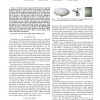Free Online Productivity Tools
i2Speak
i2Symbol
i2OCR
iTex2Img
iWeb2Print
iWeb2Shot
i2Type
iPdf2Split
iPdf2Merge
i2Bopomofo
i2Arabic
i2Style
i2Image
i2PDF
iLatex2Rtf
Sci2ools
TROB
2008
2008
Visual SLAM for Flying Vehicles
The ability to learn a map of the environment is important for numerous types of robotic vehicles. In this paper, we address the problem of learning a visual map of the ground using flying vehicles. We assume that the vehicles are equipped with one or two cheap downlooking cameras in combination with an attitude sensor. Our approach is able to construct a visual map that can later on be used for navigation. Key advantages of our approach are that it is comparably easy to implement, that it can robustly deal with noisy camera images, and that it can operate either with a monocular camera or a stereo camera system. Our technique uses visual features and estimates the correspondences between features using a variant of the PROSAC algorithm. This allows our approach to extract spatial constraints between camera poses which can then be used to address the SLAM problem by applying graph methods. Furthermore, we address the problem of efficiently identifying loop closures. We performed severa...
Camera | TROB 2008 | Vehicles | Visual Map |
| Added | 15 Dec 2010 |
| Updated | 15 Dec 2010 |
| Type | Journal |
| Year | 2008 |
| Where | TROB |
| Authors | Bastian Steder, Giorgio Grisetti, Cyrill Stachniss, Wolfram Burgard |
Comments (0)

